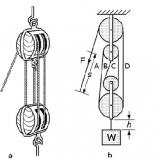Robotic Mechanisms – Four Bar Linkages 51010
What are Complex Linkages ? Four Bar Linkages ?
In addition to changing the motions of objects or forces, more complex linkages have been designed to perform many specialized functions: These include;
-drawing or tracing straight lines;
-moving objects or tools faster in a retraction stroke than in an extension stroke;
-and converting rotating motion into linear motion and vice versa.
The simplest specialized linkages are four-bar linkages. These linkages have been versatile enough to be applied in many different applications. Four-bar linkages actually have only three moving links but they have one fixed link and four pin joints or pivots. A useful mechanism must have at least four links but closed-loop assemblies of three links are useful elements in structures. Because any linkage with at least one fixed link is a mechanism, both the parallel-motion and push-pull linkages mentioned earlier are technically machines.
Four-Bar Linkage and Coupler Curve Animation
Warning : Flash Animation May not Work on Some Browsers and Mobile Platforms !
Four-bar linkages share common properties: three rigid moving links with two of them hinged to fixed bases which form a frame. Link mechanisms are capable of producing rotating, oscillating, or reciprocating motion by the rotation of a crank. Linkages can be used to convert:
• Continuous rotation into another form of continuous rotation, with a constant or variable angular velocity ratio
• Continuous rotation into oscillation or continuous oscillation into rotation, with a constant or variable velocity ratio
• One form of oscillation into another form of oscillation, or one form of reciprocation into another form of reciprocation, with a constant or variable velocity ratio
There are four different ways in which four-bar linkages can perform inversions or complete revolutions about fixed pivot points. One pivoting link is considered to be the input or driver member (Crank above) and the other is considered to be the output or driven member (Rocker above). The remaining moving link is commonly called a connecting (Coupler above) link. The fixed link, hinged by pins or pivots at each end, is called the foundation link (Frame above).
OTHER RESOURCES
Four Bar Linkage – Coupler Curve With ALGODOO
1-What is Algodoo ?: A Simple 2D-Robotic Simulation Software – ALGODOO 81002
1-Download Coupler Curve (.phz) file and run it with Algodoo
Four Bar Linkage – WOLFRAM CDF
Conceived by Mathematica (http://www.wolfram.com/products/mathematica/) creator and scientist Stephen Wolfram (http://www.stephenwolfram.com/)as a way to bring computational exploration to the widest possible audience, the Wolfram Demonstrations Project is an open-code resource that uses dynamic computation to illuminate concepts in science, technology, mathematics, art, finance, and a remarkable range of other fields.
Demonstrations can be created with just a few short lines of code. This opens the door for researchers, educators, students, and professionals at any level to create their own sophisticated mini-applications, then publish and share them with the world using Wolfram’s Computable Document Format (CDF) (http://www.wolfram.com/cdf/).
You can download Wolfram’s CDF (Computable Document Format) with the link Below
http://demonstrations.wolfram.com/PlottingClosedCurvesWithAFourBarLinkage/
Video:
-Youtube Video Link: http://youtu.be/AyII9xaAQ7M



